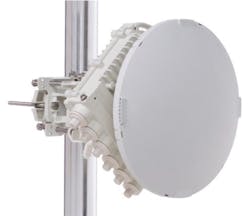In the past, I have written about wireless systems from Wi-Fi to Z Wave. Wireless has become ubiquitous in security and network installations, as it is becoming so in the smart home environment.
Cellular technology has made us accustomed the reach of wireless technology beyond our immediate surroundings. Verizon touts its 4G LTE wireless broadband as “Ten times faster than 3G — able to handle download speeds between 5 and 12 Mbps (Megabits per second) and upload speeds between 2 and 5 Mbps.” For those of us who crave more, we await 5G.
There is another term you need to get used to: WiGig. The 802.11ad WiGig specification includes communication at 60 GHz with data transfer rates up to 7 Gb/s. Just as in today’s multi-band, Wi-Fi devices will be WiGig tri-band enabled devices, which operate in the 2.4, 5 and 60 GHz bands.
There are a number of modulation and coding schemes employed to pack more data into signals in a given frequency range; however, getting another step jump in data rates requires something more, such as upping the frequency. 5G promises a couple of orders of magnitude (100x) more. In July, the FCC voted 5-0 to allocate nearly 11 GHz wide of high-frequency spectrum to 5G services. The newly freed spectrum includes 4 GHz of licensed spectrum at 28 GHz, 37 GHz and 39 GHz as well as 7 GHz of unlicensed (free to use) spectrum from 64-71 GHz, with an eye towards early deployments in 2018.
Millimeter band radio runs from 30 – 300 GHz, the term millimeter referring to the wavelength of the radio wave. Millimeter wave (mmW) has more spectrum than all unlicensed and microwave bands, combined. Modulating carrier frequencies within this wider spectrum enables data throughput to increase enormously. The ultimate example of increasing data capability with higher frequency is the use of infrared energy (i.e., light) which, when guided through a glass fiber, provides virtually unlimited bandwidth.
mmW’s have smaller beam spread than most radio frequencies we now use, allowing the use of reduced-size antennas as well as contributing to extensive re-use capabilities. However, with everything there is a tradeoff, and with higher frequencies comes less of an ability to penetrate surfaces such as walls. Current literature suggests that new wireless infrastructure models will emerge. These will include a higher density of cells (get accustomed to terms like femtocells, picocells and microcells) with effective ranges of 10 m to 0.5 km, and in-building base stations.
Although large-scale deployments are still several years away, there is a new entrant in the security market, Israel-based Siklu, which offers radio link technology that delivers carrier-grade wireless point-to-point Ethernet connectivity utilizing the 57-64 GHz license-free portion, the lightly licensed 64-66 GHz, both of the V-band spectrum, as well as the 71-76/81-85 GHz E-band.
For V-band, the distance specification is 700m typical, 1300m maximum (depending on rain environment), using a pair of 6” square, 3.5” deep radios with integrated antennas. The signal interface to the radio is a set of three GigE ports and the unit is powered by PoE+. MTBF is advertised at 90 years. Topologies, can be point-point, mesh, daisy-chain and ring. E-band radios look more like traditional microwave links and offer multi-gigabit capacity. The distance specification is 3 Km typical, 7 Km maximum (depending on rain environment).
Siklu says this technology is particularly appropriate for certain types of video surveillance networks, while offering topologies similar to those used for mobile backhaul network. “V-band radios, with their small form factor, are ideal for street-level deployments where its offered range is perfectly suited for cascading cameras,” explains Danny BenSimhon, Siklu’s Product and Solutions Marketing Manager. “E-band radios, with their higher capacities and longer range, address the aggregation layer of typical city-wide networks. The results are networks that are not bandwidth-starved and can easily handle hundreds of cameras, including high megapixel panoramic multi-sensor models. This allows devoting needed bandwidth to clusters of cameras and supports camera signal aggregation.”
Because of the narrow beam width and relatively low power, the signal is much less susceptible to compromise. Ring and mesh topologies provide means of network resilience, and GigE copper and SFP connectivity provide a straightforward means of connecting to existing wired or Wi-Fi networks. The company points to a significant installation in Fort Myers, Fla., which connected a number of Axis HD pole-mounted cameras. On each pole, the integrator placed an HD PTZ camera and two multi-sensor HD cameras, together generating 70Mbps. Siklu’s 60GHz radios, with 11 non-overlapping channels, enabled the avoidance of a time-consuming, expense generating frequency survey, leading to an implementation time of two weeks for interconnection of 49 total cameras.
While Siklu’s solution is currently unique in the security market, I think it is the harbinger of future 5G deployments. Cellular bandwidth and services will be provisioned in buildings using down-conversion to lower frequencies in the Wi-Fi range for allowing wall penetration, connection to 1 Gig/10 Gig copper/fiber networks, or via micro 5G infrastructures within buildings or defined outdoor areas.
Ray Coulombe is Founder and Managing Director of SecuritySpecifiers and RepsForSecurity.com. Reach him at [email protected], through LinkedIn at www.linkedin.com/in/raycoulombe or via Twitter, @RayCoulombe.
About the Author
Ray Coulombe
Ray Coulombe is founder of SecuritySpecifiers.com, the industry’s largest searchable database of specifiers in the physical security and ITS markets. He is also Principal Consultant for Gilwell Technology Services. He can be reached at [email protected] or through LinkedIn.

